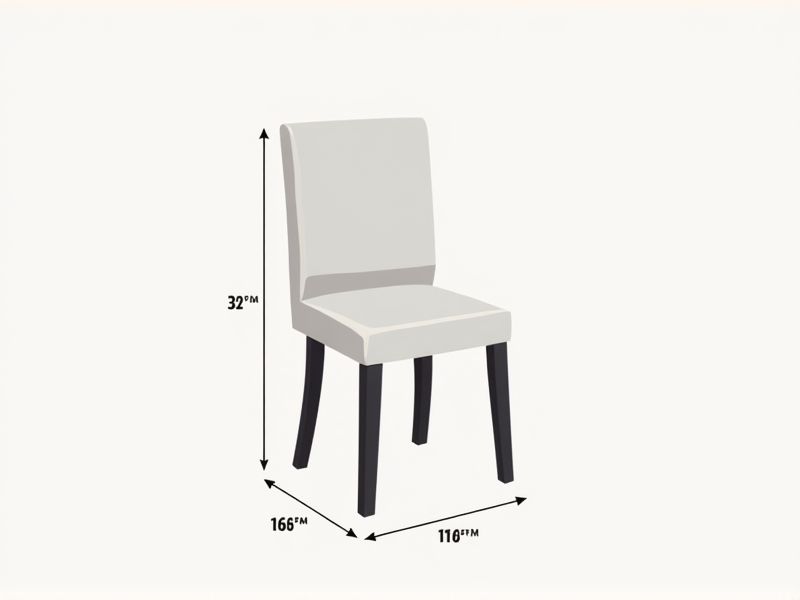
When selecting or designing a chair, it's helpful to know the standard dimensions to ensure comfort and usability. Typically, a standard dining chair seat height ranges from 17 to 19 inches (43 to 48 cm) from the floor, with a seat width of 16 to 20 inches (41 to 51 cm). The overall height from floor to the top of the chair back is usually between 30 to 34 inches (76 to 86 cm). Keeping these dimensions in mind can help you choose chairs that fit well with most tables and provide comfortable seating for most adults.
Seat Height
The standard seat height for office chairs typically ranges from 16 to 21 inches above the floor, accommodating a variety of user heights. Adjustable seat heights are crucial for promoting good posture and ergonomic comfort, allowing you to align your feet flat on the ground while maintaining a 90-degree angle at the knees. For optimal workspace usage, a seat height adjustment mechanism, whether pneumatic or manual, can enhance productivity and reduce strain during long periods of sitting. When selecting a chair, consider a height that suits your body frame, as this can significantly impact your daily comfort and health.
Seat Width
The standard seat width for office chairs typically ranges from 17 to 20 inches, accommodating various body types for optimal comfort. For individuals seeking ergonomic support, a seat width of 18 inches is often recommended, as it provides a balance between space and body support. Chairs with adjustable seat widths allow users to customize their seating, enhancing overall productivity and reducing discomfort during long hours of work. To ensure your chair meets your needs, consider measuring your hip width and comparing it with the chair's width specification before making a purchase.
Seat Depth
Seat depth is a critical ergonomic factor in chair design, typically ranging from 15 to 18 inches to accommodate various body types. An appropriate seat depth allows individuals to sit back fully against the backrest while providing support for the thighs without causing pressure behind the knees, enhancing comfort and posture. For optimal support, consider a chair with adjustable features that allow you to customize the seat depth based on your height. Research indicates that a well-chosen seat depth can significantly reduce discomfort and fatigue during prolonged sitting, improving overall productivity.
Backrest Height
The standard height of a backrest for ergonomic chairs typically ranges between 12 to 20 inches above the seat. This dimension is crucial as it provides essential lumbar support, promoting correct posture and reducing strain on the lower back. For optimal comfort, your chair should allow for adjustable backrest height, accommodating individuals with varying torso lengths. Studies indicate that a well-designed backrest can significantly enhance productivity by minimizing discomfort during long sitting periods.
Backrest Angle
The backrest angle of a chair typically ranges from 90 to 130 degrees, which is crucial for providing ergonomic support. An adjustable backrest allows you to customize the angle to suit your comfort, reducing strain on your spine during extended periods of sitting. Research shows that an optimal angle of around 100 degrees can enhance productivity by improving posture and reducing fatigue. When selecting a chair, consider those that offer features like lumbar support and adjustable backrest height for maximum comfort and functionality.
Armrest Height
Adjusting the armrest height of a chair is crucial for ergonomics, as it can reduce shoulder and neck strain. An optimal armrest height should allow your elbows to remain at a 90 to 100-degree angle while resting comfortably. Research indicates that a height of 7 to 10 inches above the seat can enhance posture and support, especially during prolonged sitting. Ensuring the armrests are adjustable can accommodate individual preferences and body types, promoting better overall comfort and productivity.
Armrest Width
The standard armrest width for office chairs typically ranges between 2 to 4 inches to provide optimal support and comfort. A width of 3 inches is commonly considered ideal for most users, allowing your arms to rest comfortably without causing strain. Ergonomically designed armrests should also offer adjustability to accommodate individual preferences and different body types. Ensuring that armrests align with the height of your desk can significantly improve your overall sitting posture and reduce fatigue during long hours of work.
Overall Chair Height
When selecting a chair, overall chair height is crucial for comfort and ergonomic support. The standard height for most office chairs ranges between 16 to 21 inches from the ground, accommodating various body types. Ensuring that your feet rest flat on the floor while sitting at a desk can enhance posture and reduce strain on your back. A properly adjusted chair not only promotes productivity but also contributes to long-term health benefits.
Leg Spacing
Chair leg spacing is crucial for stability and comfort, typically ranging from 18 to 24 inches apart for standard dining chairs. This spacing ensures that users can sit comfortably without feeling cramped while allowing for easy movement. In ergonomic designs, wider leg spacing accommodates diverse body types and enhances accessibility for all users. A well-measured chair leg arrangement not only improves functionality but also contributes to the overall aesthetic appeal of your space.
Chair Stability
Chair stability is crucial for ensuring user safety and comfort, particularly in environments where the chair will be frequently used. A well-constructed chair should support a weight capacity of at least 250 pounds, with a sturdy frame made of high-quality materials such as steel or hardwood. The design should incorporate features like a wide base and non-slip feet to prevent tipping or sliding during use. For optimal stability, look for chairs that offer adjustable features, allowing you to customize the height and tilt to suit your posture.
